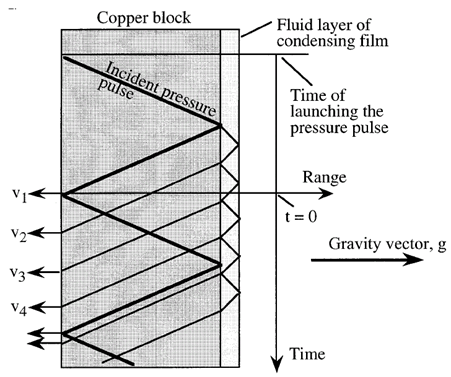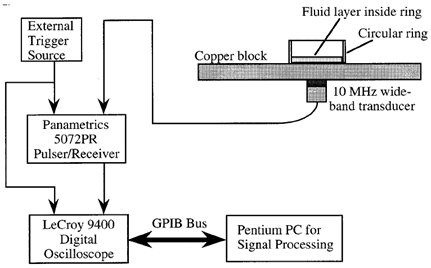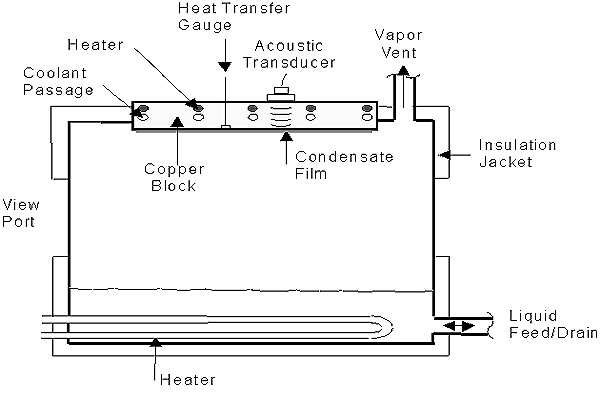The film condensation of vapor on a cooled, downward-facing surface is a complex dynamic fluid phenomenon. This research develops the theoretical basis, instrumentation approach, and experimental results for a method for ultrasonic monitoring of film condensation. The ultrasound measurement system utilizes a 10 MHz broadband contact transducer, operating in pulse–echo mode. By appropriate signal processing, condensation layers over a wide thickness range, from much less than a wavelength to several wavelengths, can readily be measured.
The physical model consists of a metal block of infinite extent, with thickness Do and acoustic impedance z1. A condensing film with uniform thickness d and acoustic impedance, z2, has formed on one side, and the pulse–echo transducer is placed on the opposite side. The analytic modeling is based on the assumption that the transducer generates a plane wave field. For the modeling of the received signal, the scattering attenuation of the copper block was ignored. Instead, the received signal from the back of the copper block, with a 5 MHz center frequency, was considered a delayed version of the transmitted pressure pulse. Figure 1 defines individual components of the output voltage from the transducer in receive mode together with their arrival times, due to reflections generated inside the copper block and multiple reflections generated inside the condensing film layer. Note that Figure 1 is a space–time diagram.

Figure 1. Diagram showing how reflections inside the copper block and multiple reflections inside the condensing film layer give rise to a series of reflections.
A finite time difference (FTD) analysis was performed, using the commercial software package Wave 2000, in order to make a comparison with the analytic modeling results. For the specific fluid layers and metals considered, the locations of the spectral peaks were nearly identical to the locations found with the analytical method, and the general spectral shapes were very close, with the differences being due to the fact that the numerical modeling was based on a transducer with finite aperture. Ultrasound verification experiments were also performed with a set-up that allowed a thin water layer of constant thickness to be established. The measurement system is shown in Figure 2 where the transducer was clamped underneath a 10 mm thick copper block on top of which was placed a ring containing the water layer. Initially, a reference echo was acquired from the dry copper surface. By applying our analytical framework on the acquired ultrasound signals, we were able to accurately measure the thickness of fluid layers as thin as 60 μm.

Figure 2. Simplified block diagram of the ultrasound instrumentation.
A series of condensation experiments with water and with methanol were conducted as well. The controlled condensation took place in a closed chamber (see Figure 3) which was 25% filled with fluid (water or methanol ) and heated to a specified temperature. The condensation formed at the underside of the copper block, placed on top of the condensation chamber and cooled to a specified temperature by means of a chiller unit. The transducer was placed between one of the cooling channels in order to acquire unimpeded reflections from the back of the copper block. For the experiments with water, the underside of the copper block was coated with a thin film of surfactant to improve wettability and minimize dropwise condensation. (Check the various stages of the condensation phenomena here. See the difference between droplet and film condensation. Look at the test chamber.)

Figure 3. Schematic diagram of the test chamber.
This effort represents the first phase of a longer-term investigation of the fluid physics of condensation processes under reduced gravity conditions. The long-term objective of this research is to define and develop a comprehensive ground-based, proof-of-concept condensation experiment, leading to the eventual development of a space-station based flight experiment. The ground-based experiment would involve testing under reduced and augmented gravity conditions in a laboratory and in reduced-gravity aircraft. This is a NASA funded project.